
long-eared owl
The long-eared owl, a distinctive species of owl with its striking feathered ears and heart-shaped face, is found in a wide variety of habitats. This fact sheet provides a detailed overview of the biology and lifestyle of the long-eared owl and highlights the importance of its protection and conservation in natural habitats.
long-eared owl Products
-
Animal display long-eared owl
Regular price From 29,90€Regular priceUnit price / per -
Animal display Long-eared owl - Outdoor set
No reviewsRegular price 35,30€Regular priceUnit price / per
Profile: long-eared owl
-
Scientific classification
- Class: Aves (birds)
- Order: Strigiformes (owls)
- Family: Strigidae (owls)
- Genus: Asio
- Species: A. otus (Long-eared owl)
-
Physical characteristics
- Size: Body length of 35-40 cm
- Wingspan: 85-103 cm
- Weight: 200-400 g
- Special features: Medium-sized owl with striking feathered ears, orange eyes, brown-grey patterned plumage with dark spots and stripes, heart-shaped face.
-
Habitat and distribution
- Common regions: Europe, North Africa, Asia
- Habitat: Diverse, from deciduous and coniferous forests to parks, gardens and hedgerows to urban areas.
-
Nutrition
- Diet: Carnivore
- Typical food: small mammals such as mice, rats, rabbits, but also birds, insects, amphibians and occasionally fish.
-
Reproduction and lifestyle
- Breeding season: Spring
- Nest building: In tree hollows, nesting boxes or abandoned crow nests
- Egg laying: 2-5 eggs per clutch
- Brood care: Females incubate the eggs, males provide food and brood care
- Social structure: Mostly in pairs or small family groups.
-
Lifespan and protection status
- Life expectancy: Up to 10 years in the wild
- Threat status: Not threatened, but habitat loss, loss of nesting sites and traffic accidents can affect local populations.
- Conservation measures: Preservation and protection of natural habitats, creation of nesting aids, raising awareness about the importance of the forest for the long-eared owl.


